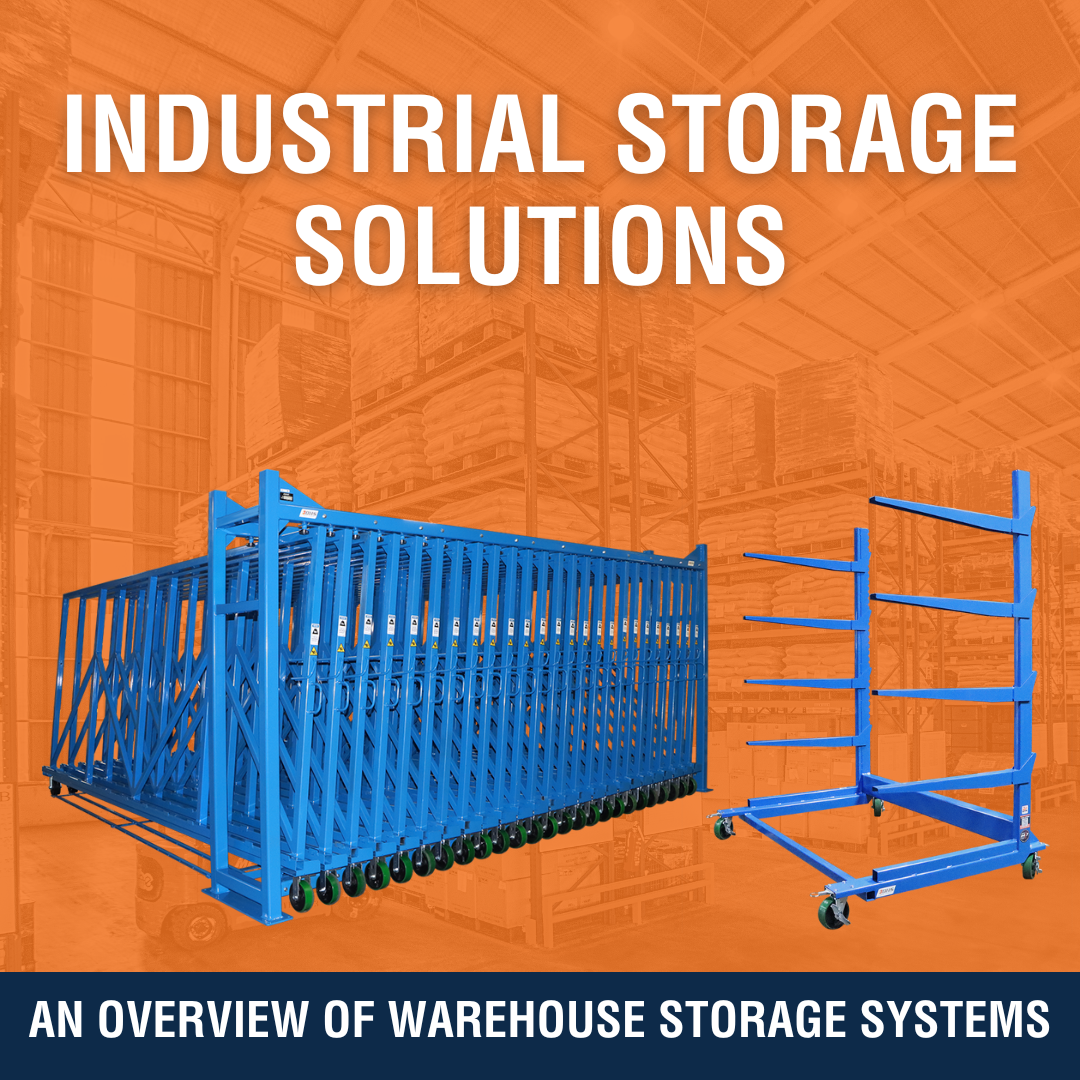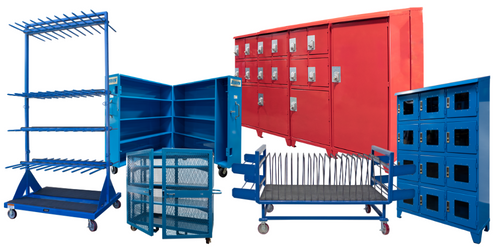We use cookies to make your experience better. To comply with the new e-Privacy directive, we need to ask for your consent to set the cookies. Learn more.
Industrial Storage Solutions: An Overview of Warehouse Storage Systems
What’s the biggest expense at your warehouse or distribution center? If your operation is like most, the answer’s probably order picking: Research suggests that order picking makes up between 50 and 75 percent of warehouse operating costs. If you want to build a more efficient operation, then, look for ways to improve order picking productivity.

That requires a careful plan and the right layout. But both of these factors depend on warehouse shelving systems that make efficient travel patterns possible. In short, the industrial storage solutions you choose have a direct impact on order-picking productivity.
Your warehouse shelving must fit into the facility’s space itself, creating aisles and traffic lanes that allow order pickers to access contents without congestion. Of course, warehouse storage systems must also be designed specifically for the materials and products you handle.
Before you choose the industrial storage products that improve throughput for your operation, take the time to understand all the options. That research begins with this article. Here are some of the leading categories of industrial storage for warehouses, distribution centers, manufacturing operations, storerooms, and other commercial storage facilities.
5 Industrial Storage Solutions for High-Throughput Operations
1. Pallet Racking
If you typically handle materials at the unit load level — and those materials are always stored on pallets — pallet racking will form the core of your warehouse operation. Pallet racking comes in a variety of configurations and designs, but according to the Rack Manufacturers Institute (RMI), there are two general categories of pallet racking: roll form and structural construction.
While both types are made of steel, roll form racking is generally lighter, thinner, and easier to install than its structural counterpart. It’s also less durable and more vulnerable to damage from lift truck strikes. That makes roll form racking a common choice in lighter-traffic warehouses and commercial operations. Higher-throughput operations often choose structural racking, since it can withstand more abuse.
Within each category, common configurations for pallet racking include:
- Selective Pallet Racking - This low-density configuration typically stores pallets a single layer deep, which allows lift trucks to access every pallet without a lot of shifting. The trade-off for this access is that selective pallet racking layout requires wide aisles, so there’s less room in your facility for storage itself.
- Very Narrow Aisle (VNA) Racking - VNA racking achieves higher storage density at the cost of aisle width. You need special VNA forklifts to access pallets in such a system, and only one vehicle can access an aisle at a time.
- Pushback Racking - These high-density storage systems are deeper than selective racks, allowing lift trucks to store pallets up to six units deep. This design supports a Last In First Out (LIFO) access strategy, which is why pushback racking systems are sometimes called LIFO racks.
- Drive In Racking - These storage systems achieve even higher density than pushback racks by storing pallets many units deep. To access these pallets, lift trucks must drive into the racking system, then back straight out.
- Pallet Flow Racking - This design takes the concept behind flow-through racking and expands it to support pallet loads. Lift trucks load pallets into the racking system from the rear. A gentle slope allows gravity to draw the pallet toward the front of the system, where lift trucks can access them for retrieval. This design supports high-density storage in a First In First Out (FIFO) access system.
To choose the right pallet racking system, you must consider the standard weight of your unit loads; available material handling equipment; and all your local building and fire codes. But what if you store items or materials that don’t fit onto pallets? That’s when you need one of the other industrial storage solutions on our list.
2. Open Industrial Shelving
For most non-palletized storage situations, open steel shelving is the go-to solution. Welded steel racks with fixed shelf heights provide the best combination of stability and impact resistance, while a powder-coat finish will add to the unit’s long-term durability.
Look for a steel shelving provider that can provide custom shelving systems to match your materials or products. Consider your required storage capacity, shelving layouts that preserve floorspace in your facility, and overall shelf height.
To ensure workplace safety, look for shelving units with large bases and pre-drilled anchor holes. That way, you can bolt units safely into place anywhere in your facility. Industrial Shelving from BHS, Inc. offers heavy duty steel construction with large, floor-protecting foot pads, and optional pre-drilled anchor holes. Custom configurations are available on request; contact BHS at 1.800.BHS.9500 to discuss the options.
3. Flow Through Racks
To really speed up order picking and access to small parts or components, look for a storage solution that keeps product close at hand. Flow Through Racks and Gravity Flow Racks feature included shelving that draws contents to the front of the rack, where staff can access it easily. This self-replenishment improves productivity while reducing ergonomic risks like reaching and bending.
Flow Through Racks from BHS, Inc. support up to 4,000 pounds of product on inclined shelves that allow gravity to push product to the front edge for easy retrieval. BHS Gravity Flow Racks line shelves with free-spinning rollers, so cartons continuously move forward as they’re used and removed. Both models feature structural steel construction and a durable powder coating for long-term use in busy production environments.
4. Specialized Material Racks
Industrial materials come in all shapes and sizes. Often, standard shelving configurations don’t provide the space saving, protection, or density you need for optimal productivity. In cases like this, look for specialized material racks designed to meet specific needs. 
Here are just a few examples:
- Store pipes, bars, rigid conduit, lumber, or similar materials on adjustable Cantilever Carts or Vertical Material Racks.
- Safely store sheet materials, from granite slabs to glass windows, on multi-tier Sheet Material Racks. Looking for portability along with storage? Choose Mobile Sheet Material Racks.
- Simplify access and organization for sheet metal stock (or similarly shaped materials) with a Vertical Sheet Rack System, which preserves floorspace with roll-out racking.
- Get secure, visible storage for staff belongings (PPE, tools, electronics, and more) with a Clear View Storage Locker.
- Keep high-value items safely locked away with Security Cages like Heavy Duty High Value Carts.
No matter what materials you handle, specialized industrial storage solutions improve space utilization and staff access — including for order picking tasks. If you can’t find the industrial storage products that match your needs, reach out to BHS. Our custom engineering team will work with you to design and manufacture an all-new solution, built to your specifications.
5. Automated Storage and Retrieval Systems
Automation is transforming warehouses and distribution centers, and not only through the use of automated guided vehicles (AGVs) and robotic palletizers. Automated storage and retrieval systems (ASRS) use shuttles, carousels, and computerized guidance to pick and put away stock — usually, but not always, at the pallet level. This automation allows ASRS racking to achieve extremely high density, since you don’t have to build in aisles for lift trucks to access.
The global market for ASRS is expected to continue growing through 2028 (at least), reaching a value of over $4 trillion that year. Still, the high cost and complex installation of these systems is likely to limit their use to very high-throughput operations — so traditional warehouse storage systems will remain essential for the foreseeable future.
Keep reading for more advice on choosing the ideal storage solution for your material handling operation.
Evaluating Large-Scale Industrial Storage Solutions
How do you know if a given racking product is likely to perform safely and efficiently for the entire lifespan of your warehouse? Look for warehouse storage systems that comply fully with industry standards
Specifically, the key standard for warehouse racking is ANSI MH16.1-2021, Design, Testing, and Utilization of Industrial Storage Racks. This is the standard referenced in other safe building codes, from the International Building Code to the National Fire Protection Association (NFPA) Building Codes. The 2021 edition is the latest set of standards from the Rack Manufacturers Institute (RMI), an industry group dedicated to promoting “the safe and effective use of industrial steel storage racks and related storage and handling systems.”
In addition to publishing and periodically revising the ANSI MH16.1 standards, RMI operates the R-Mark Certification Program. To qualify for the R-Mark, manufacturers must prove that their racking products comply with ANSI MH16.1 standards — including proof that listed load capacities for frames, beams, and decks followed RMI guidelines.
Note that, while R-Mark Certification is a strong signal that racking products will perform as advertised, it’s not sufficient to ensure a safe, productive facility on its own. According to RMI itself, “a rack owner must still have a qualified engineer review each application to ensure that the selected system components meet the requirements for the specific use and job site.”
Custom Storage Solutions for Industrial Applications
To get the most productivity gains in your material handling operation, you need storage solutions designed specifically for your operation. BHS, Inc. is a leading provider of custom warehouse equipment, including industrial storage solutions built to meet any specification. All of our products are designed, manufactured, and tested in our 148,000 square-foot facility in St. Louis, Missouri, with state-of-the-art manufacturing systems that ensure quick turnaround on every order along with industry-leading quality.
Looking for a custom storage solution for your facility? Call BHS at 1.800.BHS.9500 to start the conversation.
